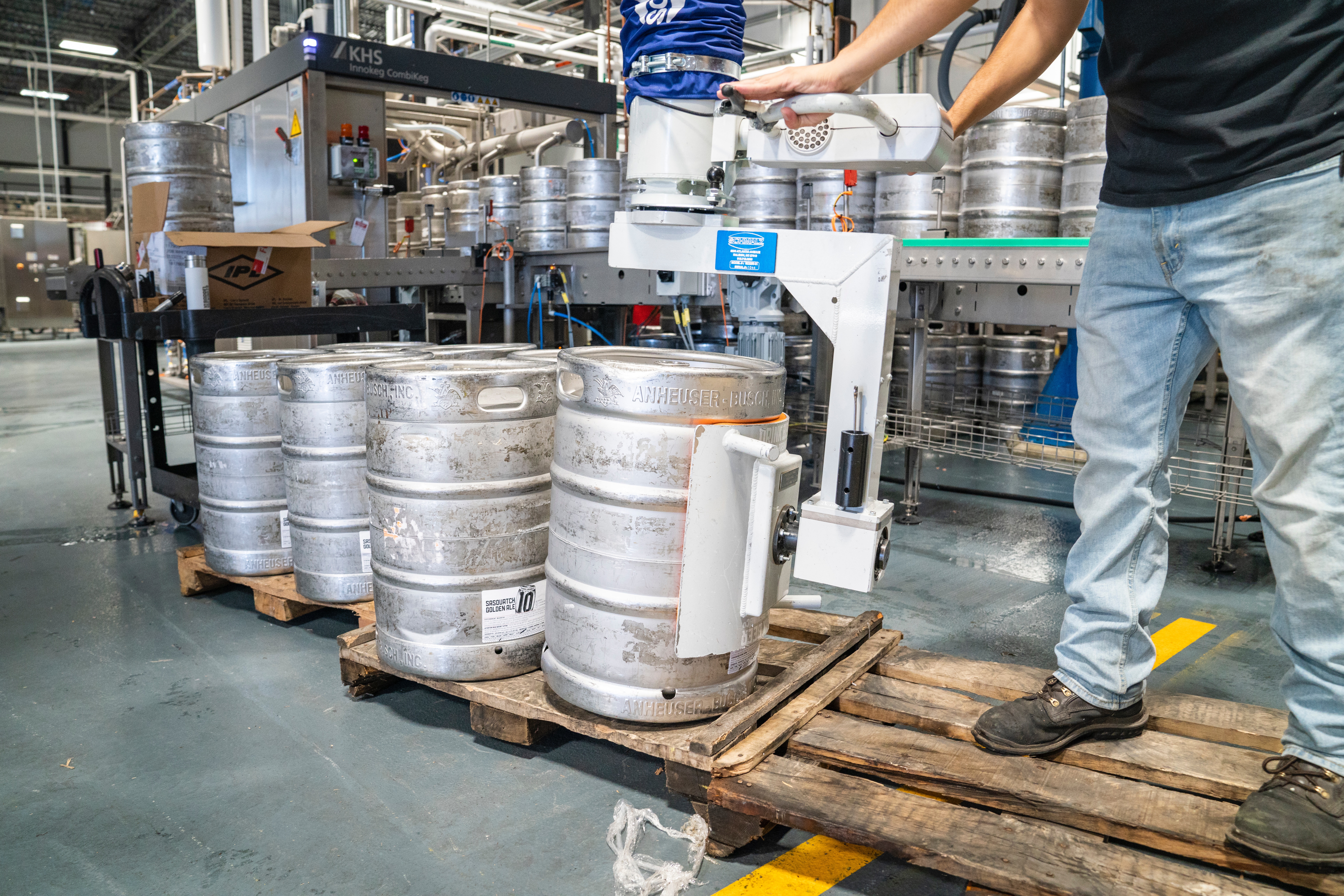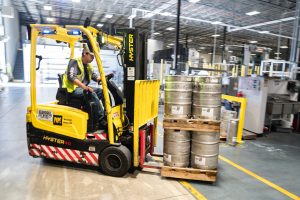
by Lean Material Handling | Dec 9, 2018 | Lean Production
What would it be like if one day we woke up and there was nothing for us to do or nothing for us to anticipate? How annoying is it that thought let alone if the situation comes to reality? Fortunately, that is not and never the case.
The world around us is continuously evolving from both the small and significant innovations that are happening in every corner of the world. There is always some part of the world that is continually working, thinking, planning, creating something new or redefining some of the old creations. This is what makes us tick and look forward to a better tomorrow. For this same reason, subjects like Project Manufacturing are gaining a lot of attention these days.
What is Project Manufacturing?
Project manufacturing is a large-scale industrial operation process that is mainly carried out to design and produce big, highly specialized, and costly products such as ships, aircraft, submarines, defense systems, customized consumer products such as automobiles, homes, and others.
However, one product manufacturing process is significantly different from the other, as every process is highly unique. Nevertheless, project manufacturing processes are quite flexible regarding operations, mainly because every product that each manufacturing project manufactures is substantially different from the other. Thus, with large project sizes of every project, the high expenses associated with each project, and the high degree of customization that is applied to each project, makes project manufacturing relatively a long duration process for each project to attain its completion phase.
Highlighting Features of Project Manufacturing
- It produces similar products in large numbers but in a unique manner. For instance, vehicle manufacturers produce similar automobile parts in larger quantities but ensuring that it all fits different vehicle requirements in some way or the other.
- It exploits the principle of using “common manufacturing requirements” to increase the efficiency rate. For instance, if two or more customized projects require the same manufacturing components, then these are produced at the same time but in larger quantities to save time and resources.
- It allows for customizations to produce unique combinations of products and services. For instance, home manufacturers will go out of business if they construct the same models of houses for all its clients. Therefore, they need to ensure that modifications are made, and customizations are accommodated as per client preference.
- Unique requirements are treated as a separate project to improve overall efficiency. For instance, manufacturing ships for defense purposes and those for cruise purposes need to be considered as two different projects rather than as one single project, as both these have different requirements.
Major Problems that Project Manufacturing Faces
No doubt, it has been concluded that Project Manufacturing is indeed a large-scale operation and like most large-scale projects, Project Manufacturing too suffers from its share of problems. Of the many issues out there, here is a look at the three major issues that most project manufacturing projects face during its project completion.
- Lack of Project Ownership & Micromanagement: The fundamental problem that most large-scale projects face is that the plan lacks proper control systems as it progresses forward, thereby going through a series of handlers who adopt micromanagement practices, which bring about a negative working environment. This in turn also results in laborers who steer away from responsibilities, and as a result, projects lose momentum through its course.
- Lack of Information: Information is knowledge. Hence, there must a proper flow of information through every channel. For instance, incomplete/inadequate/inaccurate information will result in poor project delivery. Some projects fail because the production team is not provided with adequate information and as a result, production does not meet the intended Similarly, information passed on to the customer is also important, without which product handling and usage fail.
- Material Mismanagement: Another major problem that most big manufacturers face is the problems associated with material handling and storing. While some projects experience material shortages, others face material surplus issues, both of which create additional problems. For instance, material shortages will lead to production halts and thus result in loss of revenue. On the other hand, an excessive stock is primarily viewed as locked capital, which again if not appropriately managed or diverted to other needy operations will result in reduced profits for the Company.
Solutions to Conquer the Three P’s
Problems are never-ending in any field and needless to say, a new project throws more issues than you anticipate or can handle. It is easy to list out problems, but true talent surfaces only when the root cause of the problem is identified, and the best solution to the problem is devised in the most cost-effective and least time-consuming manner. Thus, here are the best solutions that may be employed to the above the three problem statements.
- Proper Ownership: All projects, irrespective of its size and investment, must ensure appropriate management right from the start to delivery. This is crucial to provide quality, deadlines, and budgets are met within the set parameters. For this, every project must necessarily have a Project Lead/Manager who will take full ownership of the project and whose primary function is to oversee the different stages of project transformation.
- Proper flow of information: Information must be well documented and passed on to the next level to ensure project management or product usage occurs at its best. Projects should never kickstart with incomplete information such as lack of drawings or insufficient labor. It is better to put such plans on hold rather than wasting money and resources. Hence, it is vital that information is passed on smoothly from project initiation to delivery and ultimately usage.
- Efficient Material Management: Companies must plan their material requirements. For this, many useful industrial practices such as the Just-in-Time (JIT) approach, Six Sigma practices, zero waste systems, or the Kanban systems can be applied in their manufacturing processes, especially while producing standard items and procuring common raw materials.
Thus, in short, Project Manufacturing can be seen as an amalgamation of the best Industrial Manufacturing processes and the most effective Project Management systems at a standard level sharing common interests of ensuring financial gains for the company as a whole.

by Lean Material Handling | Nov 9, 2018 | Material Handling
Material Handling is the process of moving goods and materials short distances within a building, factory, facility, or warehouse. Material handling includes a wide range of different types of materials, ranging from tiny boxes to large and heavy components for manufacturing. To conduct this process of material handling, there is a wide range of material handling equipment. The types of equipment range from:
-
manual
-
semi-automated
-
and automated equipment
Material handling refers to the entire process of processing, storage, as well as the control of the goods. It is used to help create “time & place utility” through handling, storage and the control of the material (Michael G. Kay, Material Handling Equipment, 2012).
According to MHI.org:
“Material handling is the movement, protection, storage and control of materials and products throughout manufacturing, warehousing, distribution, consumption, and disposal. As a process, material handling incorporates a wide range of manual, semi-automated and automated equipment and systems that support logistics and make the supply chain work. ”

The role of material handling plays is significant and has become a topic of discussion, in particular amongst manufacturing companies. Every type of product that has been manufactured or produced has been involved in a material handling sequence of some sort. Whether that be transported via forklift, or along a conveyor line. Many large manufacturing companies invest millions of dollars every year to ensure that there material handling processes and flows are up to date and efficient.
This is where the idea of lean manufacturing and six sigma have originated, as processes and ideas to eliminate inefficiencies within manufacturing processes.
Creating an efficient material handling system for a large factory, facility or warehouse isn’t an easy take to accomplish. The dynamic environment that all industries exist in today makes it very difficult to plan long term. Especially with the development of the internet and the personalization of many products it has become more and more difficult for manufacturers to keep up with the level of customization now offered to consumers.
Material handling systems are planned out to help develop best practices and methods within a facility for long-term efficient flows. There are generally ten material handling principles which have been taken and used by a majority of facilities globally. These principles have been made and have greatly helped facility managers with the productivity, customer service, and profitability of their factories.
The ten principles of material handling (according to MHI.org) are:
- Planning Principle
- Standardization Principle
- Work Principle
- Ergonomic Principle
- Unit Load Principle
- Space utilization Principle
- System Principle
- Automation Principle
- Environmental Principle
- Life Cycle Cost Principle
These principles help with the planning and processes of all material handling and are just as relevant whether the equipment is manual, semi-automated or fully automated.
While material handling of a product does not add any direct value to the customer, how efficient or inefficient a process is, can directly affect the consumers outlook on the company, product and possibly industry.

by Lean Material Handling | Oct 15, 2018 | Warehousing
Warehouse management is easy and tricky at the same time. The stakes are high, and as such, all the logistics have to be implemented the right way otherwise face the consequences. The traditional warehouse operations have combined with today’s home delivery and online shopping creating a harsh environment for warehouse operators. One of the logistics in mind here is order picking. Order picking determines the customers’ satisfaction and the warehouse’s organization. The accuracy of the process saves time and cost as well as avoiding costly inventory errors. This is easy with the automated systems that can track orders from the moment they are placed. However, there is still some warehouse that does both the manual and machine order picking hence the need to improve the process. Lucky for you, regardless of the order picking method, we have compiled some of the ways you can adjust the process, and they are;
Analyzing product velocity
If a product is fast-moving, why then is it slotted way back? The order pickers will waste a lot of time if they have to make several trips. Even in writing, it doesn’t seem logical. Analyzing product velocity will hence save time by exposing items that should be near the shipping dock for easy access thereby optimizing the process. Such a system helps the warehouse to know the inventory that is needed most as well.
Proper inventory slotting
Order picking need not be complicated and organizing inventory is the first step to ensuring accuracy. By putting similar products together, as well as most popular ones, it makes it easy to pick orders in any method. Whether you are using zone picking, batch picking or wave picking, if the inventory has been organized strategically, the error chances are significantly reduced.
What are the picking routes?
If order pickers aren’t sure where products are, they may circle back several times leading to time wastage. Establishing picking routes based on the information obtained from the slotting and product velocity analysis helps take the guesswork out and improves accuracy. This can apply to automatic order picking as they have selected the right items in the least amount of time.
Keeping inventory data
Order picking is reliant on accurate inventory data. The data should be accurate and up-to-date. It makes identifying products fast, and less stressing. Keeping updated inventory data also assists the warehouse from committing themselves to deliver items that are out of stock and adds to the visibility of other items. Also, it shines a light on inventory that isn’t being used saving the warehouse space and money.
Using error data
Optimizing warehouse operation and order picking process will require analysis of error data. This reduces the chance of ever repeating the same mistakes. It keeps the order pickers on their toes as well since this data can be used to evaluate their accuracy. However, it is difficult to eliminate order picking errors but at least this way, you can minimize mistakes that can cost the warehouse tons of resources correcting them.
Automation
Thanks to the digital era, man and machine can work together to improve the order picking process. Warehouse automation is the way to go if you want to improve your efficiency. Software and robotics are being used to control the production lines. At the same time, they can be used to advance order picking as it becomes more efficient and fast. Embracing automation has led to many warehouses fulfilling their word for quick deliveries, and there have been minimal errors.
When customers get the right delivery, the credibility of your warehouse is rated highly. Using these few ways to improve order picking will help achieve this.

by Lean Material Handling | Aug 9, 2018 | Warehousing
Timely deliveries and meeting customers’ demands are important in helping maximize the supply chain processes. It all starts with how well you manage your warehouse operations. A poor warehouse management system will lead to huge economic losses. This is not what we are after. So we have to manage all aspects of the warehouse to ensure that at each level, we reduce cost and improve the warehouse’s efficiency.
Also, today’s rise in e-commerce demands that the warehouse is organized to fulfill customers needs. The increase in e-commerce creates pressure to the warehouse as customers expect quick home deliveries. Therefore, warehouses have to do all they can not to fail their customers otherwise lose their business. From processing the orders to loading them in trucks, their efficiency will be vital in avoiding mistakes and any delays. To achieve this, we manage the labor, freight, and inventory.
Managing labor
Even though we incorporate modern technology in the warehouse, there will still be employees to take care of picking and packaging. You will need to motivate them to double their efforts with the little time they have to do their day’s work. Offering incentive pay is a guaranteed way to boost morale and improve productivity.
Also, you will need highly trained frontline managers to manage warehouse operations on the ground. Having highly trained frontline managers will require them to know the warehouse workings, the customer’s and vendors’ needs as well as other aspects of the warehouse. That said, you can hire qualified managers or offer them training. There are several resources online, and locally that will assist frontline managers to become better.
Managing freight
If not well maintained, it dramatically affects the warehouse efficiency. The terms of the agreement and laid out policies shouldn’t compromise on product packaging and timely deliveries. Consultants can help to make sure inbound and outbound freight aren’t the source of profits going down the drain. The consultant you turn to should be experienced and know the laws surrounding freight management and negotiations. The moment freight issues are taken care of; the warehouse operations can run smoothly improving warehouse efficiency.
Managing inventory
Inventory plays a significant role in supply chain management as well as warehouse efficiency. Overstocking and dead stock usually cost you more than you think. Consequently, it would be prudent to put in place measures to control inventory.
One way of doing so is using third-party fulfillment. Through the option, one can concentrate on other areas of warehouse management as the third-party fulfillment will ensure that the inventory meets the order throughput. Also, it helps increase storage hence offering more opportunities for growth.
Managing these three aspects of the warehouse should be easy especially now that technology has become part and parcel of the whole warehouse processes. Through technology, warehouse employees can be able to deliver and produce more products, and at the same time, it is easy to track your inventory to avoid cases of overstocking and overhead stock.
This is an excellent time to manage their logistics as a way of improving warehouse efficiency since they have the opportunity to use the latest software as well as modern technology to move things along. Consequently, customers will be satisfied with the fast and accurate operations following the warehouse’s services.
All in all, warehouse efficiency is the key to reducing cost and improving productivity. Therefore, the warehouse management system you opt for should be geared towards increasing efficiency. And a system that will manage the three aspects, labor, inventory and freight, is a viable one. Thus consider the above when formulating your system.

by Lean Material Handling | Apr 9, 2018 | Lean Manufacturing, Lean Production
Lean production is the creation of an efficient flow of process and production within a manufacturing set-up. It involves the selection of the appropriate lean design that meets your company’s specific requirements.
Those manufacturers with lean manufacturing layout are more competitive in delivering products on a tight timeline than those manufacturers who don’t.
Why Is It Important To Adopt Lean Manufacturing?
Aside from giving you a competitive edge, here are the reasons to adopt lean manufacturing:
Safety for Your Employees
Since the lean factory layout takes a seamless design, you can reduce the risk of accidents during production. A lean plan eliminates unwanted obstacles in the production process. As a result, it promotes a safe workplace that is also conducive to productivity.
Expedite Work in Progress
The priority of lean manufacturing is to remove unnecessary obstacles during production. This elimination of barriers expedites work in progress. With fast production and quality products, you can exceed customer’s expectation.
Eliminates Waste
With lean manufacturing, you can reduce wastages. An efficient process results in inefficient use of resources. The result of the waste reduction is equivalent to cut costs. Reduced costs mean competitive pricing for your company.
Easy and Hassle-free Maintenance
With every piece of equipment in its appropriate place, maintenance of factory space becomes easier than usual. You don’t need to waste your valuable resources on repairs after one employee accidentally trips on your equipment. Instead, you’d be spending your resources on valuable investment such as improving the technology of your production.
 Increased Production Output
Increased Production Output
Lean production is about the effective use of time and factory space. Since your employees concentrate on producing goods, you can increase the output. You will have the resources to buy more raw materials.
The ultimate objective of adopting a lean manufacturing layout is to increase customer satisfaction. With satisfied customers, you can ensure the success of your manufacturing company.
Approaches to Lean Manufacturing
The two strategies of lean manufacturing are the Greenfield and the Brownfield method.
The Greenfield method is when you set up your new lean factory on a clean slate. It means you will transfer the production with modern machinery and new factory space. While this approach is straightforward, it is not often practical for existing manufacturing company.
The Greenfield requires financial resources, and many manufacturers can’t afford to spend more money on new equipment and plants. Sometimes, you can use your existing hardware and transfer to another location with the lean layout in place. However, the downtime of production isn’t economical for many manufacturing companies
The Brownfield approach doesn’t require new equipment or a new factory plant. It uses your existing equipment and factory plant but with a new improved layout.
The step-by-step process discussed in the next section focuses on the brownfield approach. This approach is more economical and practical.
How to Set up a Lean Factory
Gather information and evaluate your existing equipment and factory layout
Before beginning any changes in your factory, re-evaluate your process and arrangement. This process gives you an overall view of what to change and how to go over the lean design. In this step, you can identify strengths to incorporate and weaknesses to improve.
You can set up back up plans, identify goals and plan alternatives. Your goal in this step is to create a lean plan that is implementable in the shortest period.
Select the right people to work out your lean layout
You’ll need a lean team. With a lean organization, it’s easier to identify problems along the way. You can delegate important tasks to people with the necessary expertise.
Your team may compose of core people, support team and senior leaders. The core people are in charge of the primary task of creating a lean layout. They’ll be the individuals who will concentrate on building your lean layout. These people will work daily to come up with the best design for your manufacturing needs.
The support team may not be working on a daily basis in the creation of the design. However, their output is essential. Their contribution is to provide the necessary input in the re-engineering of your process. These people are usually the head of every department in your manufacturing process.
The senior leaders are the policy-making body of your company. They should understand why you’re making the necessary move to becoming a lean enterprise.
Provide training for your lean team
Training may be redundant, but it provides a refresher to your team members. It threshes out any problems regarding the implementation of the layout. With training, you can identify if an individual is fit for the position you’ve assigned during the lean process.
Conduct meetings to monitor progress
Regular meeting to track progress is essential for the success of lean manufacturing. With regular meetings, you can address problems that may arise. In this step, you can communicate the alternatives in case your company needs subcontractors to fill up manufacturing downtime during the change.
Lean production is a process that involves critical tasks. These tasks may include effective communication, identification of potential problems or knowing when to abandon inefficient alternatives.
The creation of lean design may include the use of application and methodologies. The proper identification of these methodologies is crucial to the success of your lean enterprise.







 Increased Production Output
Increased Production Output

